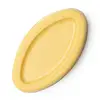What's inside
What's inside
 Benefits
Benefits

No benefits
 Concerns
Concerns

 Ingredients Side-by-side
Ingredients Side-by-side

Astrocaryum Murumuru Seed Butter
EmollientIllipe Butter
Skin ConditioningMusa Paradisiaca Fruit
AstringentTapioca Starch
Vitis Vinifera Seed Oil
EmollientTheobroma Grandiflorum Seed Butter
Skin ConditioningMangifera Indica Seed Oil
EmollientPrunus Armeniaca Kernel Oil
MaskingSimmondsia Chinensis Seed Oil
EmollientSantalum Album Oil
MaskingCistus Ladaniferus Resin
MaskingHibiscus Abelmoschus Seed Oil
MaskingDipteryx Odorata Seed Extract
MaskingGardenia Jasminoides Meristem Cell Culture Extract
Skin ConditioningCarthamus Tinctorius Flower Extract
Skin ConditioningCitral
PerfumingCoumarin
PerfumingFarnesol
PerfumingLimonene
PerfumingLinalool
PerfumingParfum
MaskingAstrocaryum Murumuru Seed Butter, Illipe Butter, Musa Paradisiaca Fruit, Tapioca Starch, Vitis Vinifera Seed Oil, Theobroma Grandiflorum Seed Butter, Mangifera Indica Seed Oil, Prunus Armeniaca Kernel Oil, Simmondsia Chinensis Seed Oil, Santalum Album Oil, Cistus Ladaniferus Resin, Hibiscus Abelmoschus Seed Oil, Dipteryx Odorata Seed Extract, Gardenia Jasminoides Meristem Cell Culture Extract, Carthamus Tinctorius Flower Extract, Citral, Coumarin, Farnesol, Limonene, Linalool, Parfum
Astrocaryum Murumuru Seed Butter
EmollientMaranta Arundinacea Root Powder
Skin ConditioningCymbopogon Citratus Leaf
MaskingSynthetic Japan Wax
EmollientCopernicia Cerifera Wax
Theobroma Grandiflorum Seed Butter
Skin ConditioningAniba Rosaeodora Wood Oil
AstringentCarapa Guaianensis Oil PEG-8 Esters
EmollientDipteryx Odorata Seed Extract
MaskingCitrus Aurantium Sinensis Fiber
Emulsion StabilisingWater
Skin ConditioningGardenia Jasminoides Meristem Cell Culture Extract
Skin ConditioningBenzyl Benzoate
AntimicrobialCitral
PerfumingCoumarin
PerfumingGeraniol
PerfumingLimonene
PerfumingLinalool
PerfumingParfum
MaskingCopper Chlorophyll
Cosmetic ColorantAstrocaryum Murumuru Seed Butter, Maranta Arundinacea Root Powder, Cymbopogon Citratus Leaf, Synthetic Japan Wax, Copernicia Cerifera Wax, Theobroma Grandiflorum Seed Butter, Aniba Rosaeodora Wood Oil, Carapa Guaianensis Oil PEG-8 Esters, Dipteryx Odorata Seed Extract, Citrus Aurantium Sinensis Fiber, Water, Gardenia Jasminoides Meristem Cell Culture Extract, Benzyl Benzoate, Citral, Coumarin, Geraniol, Limonene, Linalool, Parfum, Copper Chlorophyll
Alternatives
Ingredients Explained
These ingredients are found in both products.
Ingredients higher up in an ingredient list are typically present in a larger amount.
Astrocaryum Murumuru Seed Butter isn't fungal acne safe.
Citral is a fragrance and used to add a lemon-like scent to products. It is both naturally found in plants and created synthetically. In plants, it is commonly occurring in lemon myrtle, lemongrass, lemon tea-tree, lemon verbena, and other citruses.
The EU mandates Citral be listed separately as a fragrance. It is a known allergen and may cause contact dermatitis. Citral can also used as a masking ingredient.
The term 'fragrance' is not regulated in many countries. In many cases, it is up to the brand to define this term. For instance, many brands choose to label themselves as "fragrance-free" because they are not using synthetic fragrances. However, their products may still contain ingredients such as essential oils that are considered a fragrance.
The term 'citral' is a collective term for two geometric isomers: geranial/Citral A and neral/Citral B.
Learn more about CitralCoumarins are a group of substances found naturally in plants. There are over 1300 types of coumarins identified. It has a natural vanilla scent.
Coumarin is an identified EU known allergy, meaning it may cause an allergic reaction when applied to the skin.
In many countries, coumarin is banned as a food additive. However, it can be found in soaps, tobacco products, and some alcohol drinks.
Plants use coumarins as a chemical defense. Some plants that have coumarins include lavender, tonka beans, and yellow clovers.
Learn more about CoumarinThis ingredient comes from the tonka bean tree.
We don't have a description for Gardenia Jasminoides Meristem Cell Culture Extract yet.
Limonene is a fragrance that adds scent and taste to a formulation.
It's found in the peel oil of citrus fruits and other plants such as lavender and eucalyptus. The scent of limonene is generally described as "sweet citrus".
Limonene acts as an antioxidant, meaning it helps neutralize free radicals.
When exposed to air, oxidized limonene may sensitize the skin. Because of this, limonene is often avoided by people with sensitive skin.
The term 'fragrance' is not regulated in many countries. In many cases, it is up to the brand to define this term. For instance, many brands choose to label themselves as "fragrance-free" because they are not using synthetic fragrances. However, their products may still contain ingredients such as essential oils that are considered a fragrance.
Learn more about LimoneneLinalool is a fragrance and helps add scent to products. It's derived from common plants such as cinnamon, mint, citrus, and lavender.
Like Limonene, this ingredient oxidizes when exposed to air. Oxidized linalool can cause allergies and skin sensitivity.
This ingredient has a scent that is floral, spicy tropical, and citrus-like.
Learn more about LinaloolParfum is a catch-all term for an ingredient or more that is used to give a scent to products.
Also called "fragrance", this ingredient can be a blend of hundreds of chemicals or plant oils. This means every product with "fragrance" or "parfum" in the ingredients list is a different mixture.
For instance, Habanolide is a proprietary trade name for a specific aroma chemical. When used as a fragrance ingredient in cosmetics, most aroma chemicals fall under the broad labeling category of “FRAGRANCE” or “PARFUM” according to EU and US regulations.
The term 'parfum' or 'fragrance' is not regulated in many countries. In many cases, it is up to the brand to define this term.
For instance, many brands choose to label themselves as "fragrance-free" because they are not using synthetic fragrances. However, their products may still contain ingredients such as essential oils that are considered a fragrance by INCI standards.
One example is Calendula flower extract. Calendula is an essential oil that still imparts a scent or 'fragrance'.
Depending on the blend, the ingredients in the mixture can cause allergies and sensitivities on the skin. Some ingredients that are known EU allergens include linalool and citronellol.
Parfum can also be used to mask or cover an unpleasant scent.
The bottom line is: not all fragrances/parfum/ingredients are created equally. If you are worried about fragrances, we recommend taking a closer look at an ingredient. And of course, we always recommend speaking with a professional.
Learn more about ParfumTheobroma Grandiflorum Seed Butter isn't fungal acne safe.